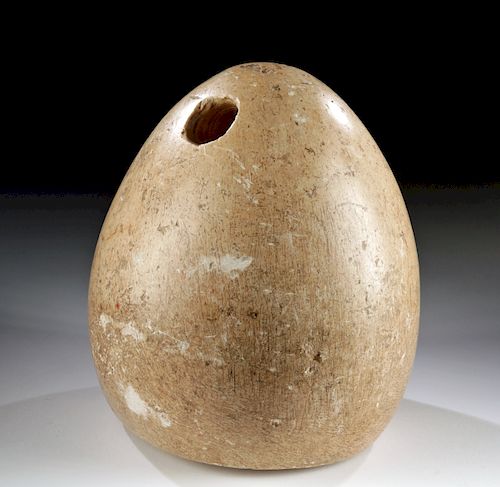Large Ancient Bactrian Stone Aniconic Weight
Lot 124
About Seller
Artemis Gallery
686 S Taylor Ave, Ste 106
Louisville, CO 80027
United States
Selling antiquities, ancient and ethnographic art online since 1993, Artemis Gallery specializes in Classical Antiquities (Egyptian, Greek, Roman, Near Eastern), Asian, Pre-Columbian, African / Tribal / Oceanographic art. Our extensive inventory includes pottery, stone, metal, wood, glass and textil...Read more
Categories
Estimate:
$2,000 - $3,000
Absentee vs Live bid
Two ways to bid:
- Leave a max absentee bid and the platform will bid on your behalf up to your maximum bid during the live auction.
- Bid live during the auction and your bids will be submitted real-time to the auctioneer.
Bid Increments
| Price | Bid Increment |
|---|---|
| $0 | $25 |
| $300 | $50 |
| $1,000 | $100 |
| $2,000 | $250 |
| $5,000 | $500 |
| $10,000 | $1,000 |
| $20,000 | $2,500 |
| $50,000 | $5,000 |
| $100,000 | $10,000 |
| $200,000 | $20,000 |
About Auction
By Artemis Gallery
Sep 26, 2019
Set Reminder
2019-09-26 10:00:00
2019-09-26 10:00:00
America/New_York
Bidsquare
Bidsquare : Exceptional Day 1: Antiquities & Asian Art
https://www.bidsquare.com/auctions/artemis-gallery/exceptional-day-1-antiquities-asian-art-4437
Day 1 of an important 2-day auction featuring exceptional, museum-worthy examples of Egyptian, Greek, Etruscan, Roman, Viking, Russian, Near Eastern, as well as Asian Art from China, Japan, Thailand, Vietnam, Burma and India. Artemis Gallery info@artemisgallery.com
Day 1 of an important 2-day auction featuring exceptional, museum-worthy examples of Egyptian, Greek, Etruscan, Roman, Viking, Russian, Near Eastern, as well as Asian Art from China, Japan, Thailand, Vietnam, Burma and India. Artemis Gallery info@artemisgallery.com
- Lot Description
Ancient Central Asia / Asia Minor, Bactria, ca. late 3rd to early 2nd millennium BCE. A hefty weight of a sizable form, hand-carved from beige-hued stone with brown and white inclusions. The weight is defined by a flat base, a rounded, egg-shaped body, a tapered shoulder with a rounded top, and a pair of diagonally-drilled suspension holes that meet within the middle. Traces of red and white pigment suggest this weight was at one time painted with vivid pigment. Aniconic objects like this example were used as large-scale weights for accurate disbursement of quantities of foodstuffs or medicinal components, and were also used for various construction-related tasks, serving as a stabilization weight or a large plumb bob for example. Scholars also posit, however, that they could have also assumed ritual or funerary contexts. Size: 6.7" W x 7.25" H (17 cm x 18.4 cm).
A lot of two stylistically-similar examples, one of a slightly taller size, hammered for $10,000 at Christie's, New York "Antiquities" auction (sale 3798, December 9, 2015, lot 98): https://www.christies.com/lotfinder/ancient-art-antiquities/two-bactrian-stone-weights-circa-late-3rd-early-5958671-details.aspx?from=searchresults&intObjectID=5958671&sid=b8d2050d-d305-449d-8806-c6ff70ff90fa
Provenance: private East Coast, USA collection; ex-Florida, USA private collection
All items legal to buy/sell under U.S. Statute covering cultural patrimony Code 2600, CHAPTER 14, and are guaranteed to be as described or your money back.
A Certificate of Authenticity will accompany all winning bids.
We ship worldwide and handle all shipping in-house for your convenience.
#149184Minor nicks and abrasions to top, body, and base, with light encrustations, and fading to original pigmentation, otherwise intact and very good. Light earthen deposits throughout.Condition
- Shipping Info
-
All shipping is handled in-house for your convenience. Your invoice from Artemis Gallery will include shipping calculation instructions. If in doubt, please inquire BEFORE bidding for estimated shipping costs for individual items.
-
- Buyer's Premium



 EUR
EUR CAD
CAD AUD
AUD GBP
GBP MXN
MXN HKD
HKD CNY
CNY MYR
MYR SEK
SEK SGD
SGD CHF
CHF THB
THB















